Design & Build a Water Tower
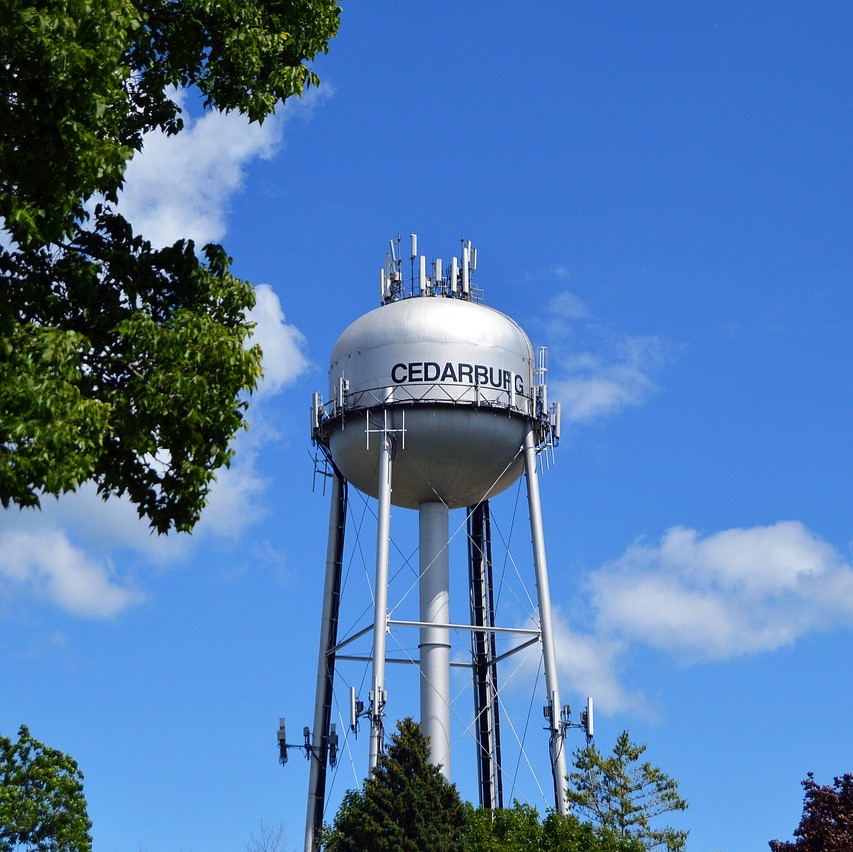
Cedarburg water tower (Quinn Kampschroer, Pixabay)

Cedarburg water tower (Quinn Kampschroer, Pixabay)
How does this align with my curriculum?
| Grade | Course | Topic |
|---|
Students will design and build a model water tower and learn why these structures are important for many communities. Grade 8 extensions are also included.
Overview
| Activities | Timing | Student grouping | Description |
|---|---|---|---|
| Minds-On: Research and Understand the Problem | 20 minutes | Large group | Students identify the general structure and purpose of water towers. |
| Action: Design, Build and Test and Share a Prototype | 40 minutes | Small group | Students design, build and test their water tower models |
| Consolidation: Competitive Bidding and Reflection | 30 minutes | Large group | Students argue the merits of their models in terms of the structure and cost. |
This lesson can be done over a few days.
Students will:
- Learn about the structure, function and importance of water tall towers
- Use an engineering design process and associated skills to design, build, and test a structure
- Investigate how science and technology can be used to address real-world problems
Learning Goals
Students will:
- Learn about the structure, function and importance of water tall towers
- Use an engineering design process and associated skills to design, build, and test a structure
- Investigate how science and technology can be used to address real-world problems
Students can:
- Use a collaborative engineering design process and associated skills to safely design, build and test model water tower
- identify environmental, social, and economic factors that should be considered when designing and building a water tower
- identify the internal and external forces applied on a structure
- describe factors that can cause a structure to fail'
- Safely use tools and materials
Success Criteria
Students can:
- Use a collaborative engineering design process and associated skills to safely design, build and test model water tower
- identify environmental, social, and economic factors that should be considered when designing and building a water tower
- identify the internal and external forces applied on a structure
- describe factors that can cause a structure to fail'
- Safely use tools and materials
This icon indicates potential assessment opportunities.
Observations
- Observe and record anecdotally students ability to actively listen and share ideas during large group discussions (Minds-on, Action, Consolidation).
- Observe and record anecdotally students' ability to follow an engineering design process (Minds-on, Action).
- Listen to and record students as they share ideas for the criteria of the water tower (Action).
- Observe and record using audio or video how students plan to go about building their water towers (Action).
- Observe and record students’ safe use of tools and materials (Action).
Conversations
- Talk with students about their design sketches. Encourage students to describe their sketches in words and explain how their ideas meet the design criteria (Action).
- Talk with students about the process of building their water towers, including challenges they encountered and how they overcame them (Consolidation).
Products
- Students could submit their notes and drawings that are part of the Water Tower Design Journal reproducible (Action).
- Students could submit a written or video of the sales pitch (Consolidation)
- Students could submit completed Water Tower Exit Slips (Consolidation).
Evidence of Student Learning
This icon indicates potential assessment opportunities.
Observations
- Observe and record anecdotally students ability to actively listen and share ideas during large group discussions (Minds-on, Action, Consolidation).
- Observe and record anecdotally students' ability to follow an engineering design process (Minds-on, Action).
- Listen to and record students as they share ideas for the criteria of the water tower (Action).
- Observe and record using audio or video how students plan to go about building their water towers (Action).
- Observe and record students’ safe use of tools and materials (Action).
Conversations
- Talk with students about their design sketches. Encourage students to describe their sketches in words and explain how their ideas meet the design criteria (Action).
- Talk with students about the process of building their water towers, including challenges they encountered and how they overcame them (Consolidation).
Products
- Students could submit their notes and drawings that are part of the Water Tower Design Journal reproducible (Action).
- Students could submit a written or video of the sales pitch (Consolidation)
- Students could submit completed Water Tower Exit Slips (Consolidation).
Students will:
- Learn about the structure, function and importance of water tall towers
- Use an engineering design process and associated skills to design, build, and test a structure
- Investigate how science and technology can be used to address real-world problems
Learning Goals
Students will:
- Learn about the structure, function and importance of water tall towers
- Use an engineering design process and associated skills to design, build, and test a structure
- Investigate how science and technology can be used to address real-world problems
Students can:
- Use a collaborative engineering design process and associated skills to safely design, build and test model water tower
- identify environmental, social, and economic factors that should be considered when designing and building a water tower
- identify the internal and external forces applied on a structure
- describe factors that can cause a structure to fail'
- Safely use tools and materials
Success Criteria
Students can:
- Use a collaborative engineering design process and associated skills to safely design, build and test model water tower
- identify environmental, social, and economic factors that should be considered when designing and building a water tower
- identify the internal and external forces applied on a structure
- describe factors that can cause a structure to fail'
- Safely use tools and materials
This icon indicates potential assessment opportunities.
Observations
- Observe and record anecdotally students ability to actively listen and share ideas during large group discussions (Minds-on, Action, Consolidation).
- Observe and record anecdotally students' ability to follow an engineering design process (Minds-on, Action).
- Listen to and record students as they share ideas for the criteria of the water tower (Action).
- Observe and record using audio or video how students plan to go about building their water towers (Action).
- Observe and record students’ safe use of tools and materials (Action).
Conversations
- Talk with students about their design sketches. Encourage students to describe their sketches in words and explain how their ideas meet the design criteria (Action).
- Talk with students about the process of building their water towers, including challenges they encountered and how they overcame them (Consolidation).
Products
- Students could submit their notes and drawings that are part of the Water Tower Design Journal reproducible (Action).
- Students could submit a written or video of the sales pitch (Consolidation)
- Students could submit completed Water Tower Exit Slips (Consolidation).
Evidence of Student Learning
This icon indicates potential assessment opportunities.
Observations
- Observe and record anecdotally students ability to actively listen and share ideas during large group discussions (Minds-on, Action, Consolidation).
- Observe and record anecdotally students' ability to follow an engineering design process (Minds-on, Action).
- Listen to and record students as they share ideas for the criteria of the water tower (Action).
- Observe and record using audio or video how students plan to go about building their water towers (Action).
- Observe and record students’ safe use of tools and materials (Action).
Conversations
- Talk with students about their design sketches. Encourage students to describe their sketches in words and explain how their ideas meet the design criteria (Action).
- Talk with students about the process of building their water towers, including challenges they encountered and how they overcame them (Consolidation).
Products
- Students could submit their notes and drawings that are part of the Water Tower Design Journal reproducible (Action).
- Students could submit a written or video of the sales pitch (Consolidation)
- Students could submit completed Water Tower Exit Slips (Consolidation).
Materials and Preparation
| Material/Technology/Setting | Quantity |
|---|---|
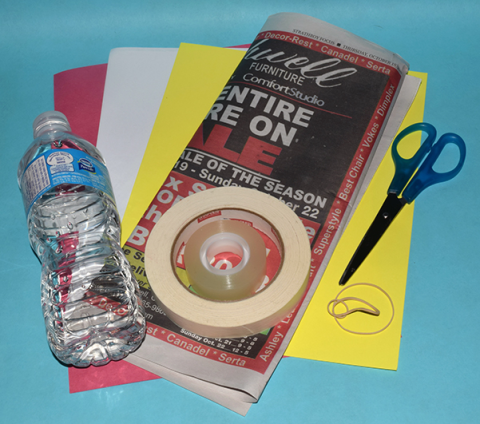
Image - Text versionShown is a colour photograph of several types of paper, tape, scissors, elastic bands and a bottle of water.
|
Will depend on criteria for the tower |
|
1 per group |
|
1 per student |
Materials
| Material/Technology/Setting | Quantity |
|---|---|

Image - Text versionShown is a colour photograph of several types of paper, tape, scissors, elastic bands and a bottle of water.
|
Will depend on criteria for the tower |
|
1 per group |
|
1 per student |
- Collect the materials that students will use to construct the prototype water towers. The materials list above is only a suggested list.
- Students could all be provided with the exact same materials and tools or students could choose their own materials.
Preparation
- Collect the materials that students will use to construct the prototype water towers. The materials list above is only a suggested list.
- Students could all be provided with the exact same materials and tools or students could choose their own materials.
- Able to work with basic cutting and fastening tools and everyday materials (e.g, paper, tape, etc).
- Familiarity with the concepts of internal and external forces, stability and centre of gravity.
Student Prior Knowledge and Skills
- Able to work with basic cutting and fastening tools and everyday materials (e.g, paper, tape, etc).
- Familiarity with the concepts of internal and external forces, stability and centre of gravity.
| Material/Technology/Setting | Quantity |
|---|---|

Image - Text versionShown is a colour photograph of several types of paper, tape, scissors, elastic bands and a bottle of water.
|
Will depend on criteria for the tower |
|
1 per group |
|
1 per student |
Materials
| Material/Technology/Setting | Quantity |
|---|---|

Image - Text versionShown is a colour photograph of several types of paper, tape, scissors, elastic bands and a bottle of water.
|
Will depend on criteria for the tower |
|
1 per group |
|
1 per student |
- Collect the materials that students will use to construct the prototype water towers. The materials list above is only a suggested list.
- Students could all be provided with the exact same materials and tools or students could choose their own materials.
Preparation
- Collect the materials that students will use to construct the prototype water towers. The materials list above is only a suggested list.
- Students could all be provided with the exact same materials and tools or students could choose their own materials.
- Able to work with basic cutting and fastening tools and everyday materials (e.g, paper, tape, etc).
- Familiarity with the concepts of internal and external forces, stability and centre of gravity.
Student Prior Knowledge and Skills
- Able to work with basic cutting and fastening tools and everyday materials (e.g, paper, tape, etc).
- Familiarity with the concepts of internal and external forces, stability and centre of gravity.
Teaching and Learning Activities
This icon indicates potential assessment opportunities.
Minds-On: Research and Understand the Problem [20 min.]
| Instructions | Teaching Tips |
|---|---|
|
Show the students a picture of a water tower, such as: 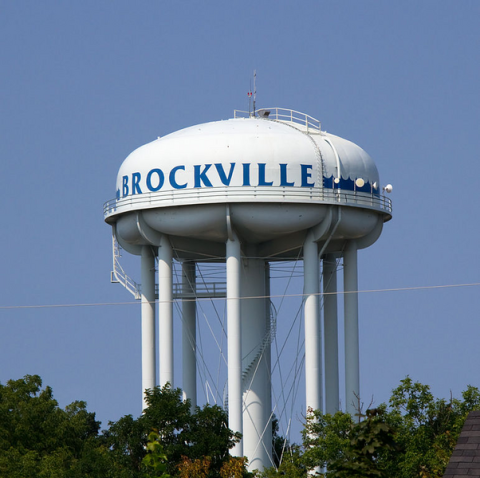
Image - Text versionShown is a colour photograph of a tall white tower with legs supporting a round top, stretching far above treetops. Ideally, it would be an image of a water tower in your community. Have students identify what this structure is.
|

Community ConnectionsIf there is not a water tower in your community, have students do an online search for the nearest water tower.
Images and VideosFor students who have visual impairment, describe the image. |
|
Show students the video How Do Water Towers Work? (4:30 min.). How Do Water Towers Work? Concerning Reality (2018, 4:31 min). Note: The units used in the video are in imperial units. As a class, discuss the purpose and function of water towers. You may wish to use the discussion prompts on the right. A water tower is an elevated structure supporting a water tank. Their main function is to help supply pressure to municipal water systems. An advantage of water towers is that they use gravity to create pressure. In this way, water can be pumped out of them without needing a source of power. When demand for water is low, water can be pumped up into the water tower. When demand for water is high, the water can be let out, which helps to keep pressure up in the rest of the system. Water towers can also store clean drinking (potable) water and be a source of water for firefighting or when other water systems are not working. |
DiscussionsDiscussion prompts can include:
|
|
Explain to the students that their community (hypothetically) is in need of a water tower. It will be up to them to submit designs and build a prototype of a water tower. You can decide if you want the water tower to function (i.e., be able to pump water into and out of the reservoir) or not. You may wish to share and review the Water Tower Single-Point Rubric reproducible [Google doc] [Word doc] [PDF] with students at this point. 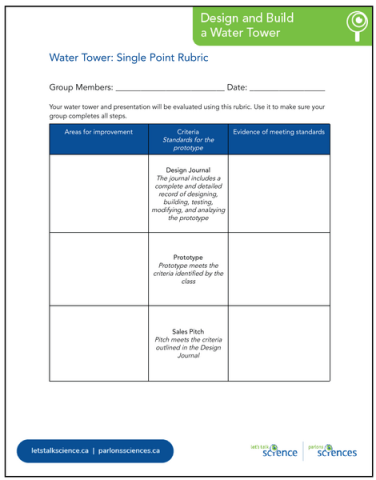
As a class, discuss some of the factors that could impact the strength and stability of their water towers. You may wish to use the discussion prompts on the right. If students need to review the concepts of internal and external forces on structures, they could watch the video Identifying Internal Forces Acting on Structures (2021, 1:30 min.). Identifying Internal Forces Acting on Structures - Grade 5 Science: Identifying Internal Forces Acting on Structures (2021, 1:30 min). |
DiscussionsDiscussion prompts can include:
|
Action: Design, Build and Test and Share a Prototype [40 min.]
| Instructions | Teaching Tips |
|---|---|
|
As a class, have students co-construct success criteria that their prototype water tower must meet. Note:
|

Community ConnectionsYou could take students on a field trip to the closest water tower so that students can observe the towers up-close and do measurement. You may even be able to have an employee give students a tour. If there is no water tower in the community, students could find out how the system works without one. DiscussionsDiscussion prompts can include:
|
|
Once the criteria have been determined, they could be recorded as a checklist. If you wish, you could adapt the Water Tower Criteria Checklist reproducible [Google doc] [Word doc] [PDF] and provide it to students as a way for them to ensure their prototypes meet the success criteria. 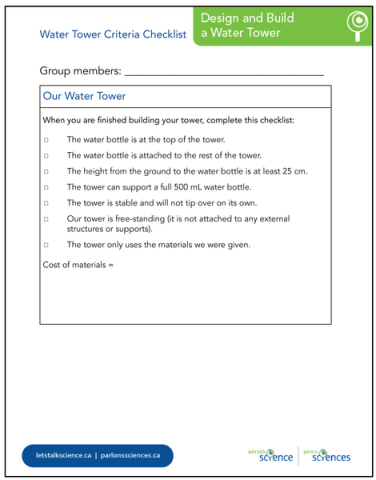
|
|
|
As a class, have students co-construct the “cost” of each material. Alternatively, adapt the Materials Price List and Budget [Google doc] [Word doc] [PDF] to suit the materials students will be using. The cost to build the tower will be taken into consideration as part of the consolidation activity. 
|
IdeaYou may wish to provide students with a fixed budget (e.g, they all get $10 dollars to spend on whicheven materials they wish), or use cost as a criteria for the competitive building activity in the consolidation. |
|
Next, provide students with the Water Tower Design Journal reproducible [Google doc] [Word doc] [PDF]. 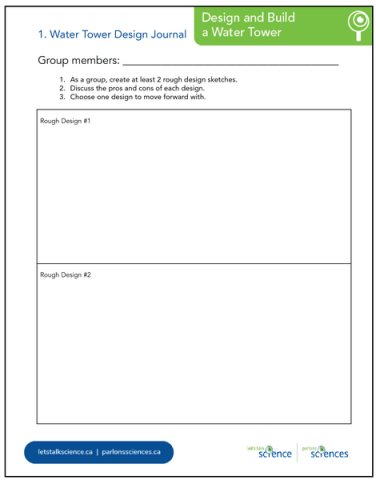
As students are brainstorming design ideas and creating sketches, have conversations with each group using discussion prompts such as the ones on the right. Have students complete pages 1 and 2 before they get materials and start building. |
DiscussionsDiscussion prompts can include:
|
|
Have students build their water towers based on the Design Journal. and record how they built their tower on page 3 of the Water Tower Design Journal. They may or may not want to work with the full water bottle at this point. If they build the rest of the structure before adding the water bottle, encourage them to think about the possible impacts of this decision. As students are building and testing, have conversations with each group using discussion prompts such as the ones on the right. 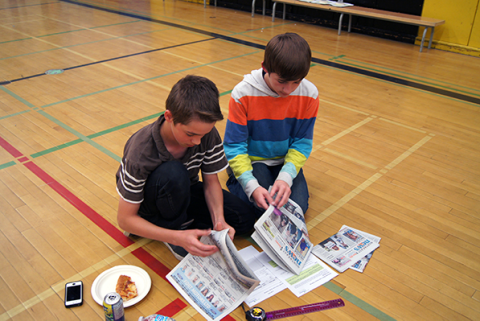
Image - Text versionShown is a colour photograph of two students unfolding newspapers on a gym floor. |
DiscussionsDiscussion prompts can include:
|
|
As students modify and retest, have conversations about why and how they are making modifications. These changes can be recorded on page 4 of the Water Tower Design Journal. 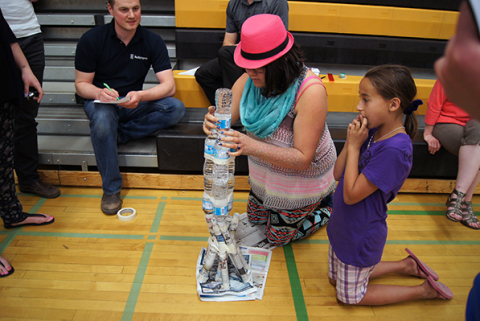
Image - Text versionShown is a colour photograph of two students placing water bottles on a tower made of newspaper, while a teacher and other students watch. Once the prototypes are complete, have students create a drawing or add a photograph to page 5 of the Water Tower Design Journal. |
DiscussionsDiscussion prompts can include:
|
Consolidation: Competitive Bidding and Reflection [30 min.]
| Instructions | Teaching Tips |
|---|---|
|
One way to consolidate the project is to have students present their water towers in the form of a sales pitch to a community representative (you) who is looking to build a new water tower in the community, similar to the TV show Shark Tank. Instructions and criteria are provided on page 6 of the Water Tower Design Journal. These can be customized to meet the needs of the class. |
IdeaTo give students an idea of what this looks like, they could watch a pitch done by a child on Shark Tank. |
|
Students could wrap up by doing a self-reflection such as the Water Tower 3-2-1 Exit Slip reproducible [Google doc] [Word doc] [PDF]. 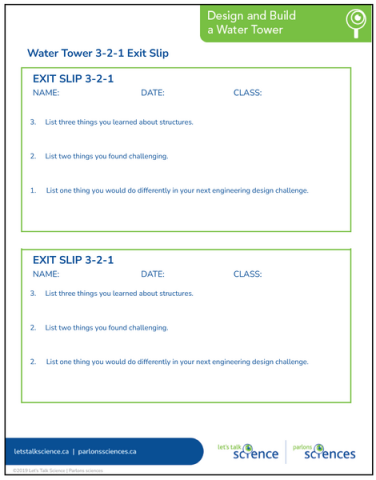
|
Background Information for Teachers
Water Towers
Water towers come in many different shapes and sizes. In most cases, the centre of gravity lies in the water tank, which is at the top of the structure. This means that the structure supporting the water tank needs to be both strong and stable.
Many water towers are narrower at the top than at the bottom to distribute the downward force across a larger area. Other designs use additional supports to brace the tank. Some use neither of these methods and instead rely on the strength of the material, usually concrete, to withstand the downward force.
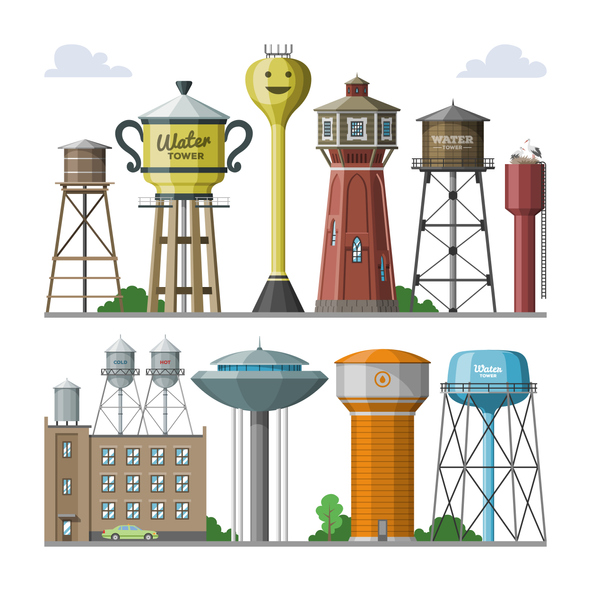
Image - Text version
Shown is a colour illustration of ten water towers in different sizes, shapes and colours.
The towers are in two rows, against a white background with a few grey clouds.
Starting on the top left, the first tower has an octagonal brown wood tank with a silver roof and octagonal thin, cross-braced legs. The second has a round yellow tank with two green handles, like a large cup. It is supported by four, wider wooden legs. The third is yellow and shaped like an upside down tear drop, with a thin yellow stem and round top. The fourth is red and shaped like an octagonal light house, with a tall, tapered lower section, punctuated by small windows, and a wider tank with a window on each side. The fifth has an octagonal wooden tank, supported by a thin, cross-braced legs and a wider central stem. The sixth is smaller and red with a tall, narrow tank on a slightly narrower red stem.
On the bottom row, from the left, is a building with three silver water towers on the roof. One has short legs, while the others have taller, thin, cross-braced ones. The next tower has a very wide, round, silver top section, shaped like a UFO. It stands on a grey stem with two thing white legs on either side. The next is orange with a thick, octagonal base and a slightly wider top section. The last tower is blue with a wide, thick, round tank on a blue stem surrounded by six thin, cross-braced legs.
Additional Resources
Reproducibles
- Water Tower Criteria Checklist reproducible [Google doc] [Word doc] [PDF]
- Water Tower Design Journal reproducible [Google doc] [Word doc] [PDF]
- Water Tower Single-Point Rubric reproducible [Google doc] [Word doc] [PDF]
- Materials Price List and Budget [Google doc] [Word doc] [PDF]
- Water Tower 3-2-1 Exit Slip reproducible [Google doc] [Word doc] [PDF]
Videos
- How Do Water Towers Work? (2018, 4:30 min.).
- How Water Towers Work (2019, 10:59 min.) (good for Grade 8)
Reproducibles and Media
Reproducibles
- Water Tower Criteria Checklist reproducible [Google doc] [Word doc] [PDF]
- Water Tower Design Journal reproducible [Google doc] [Word doc] [PDF]
- Water Tower Single-Point Rubric reproducible [Google doc] [Word doc] [PDF]
- Materials Price List and Budget [Google doc] [Word doc] [PDF]
- Water Tower 3-2-1 Exit Slip reproducible [Google doc] [Word doc] [PDF]
Videos
- How Do Water Towers Work? (2018, 4:30 min.).
- How Water Towers Work (2019, 10:59 min.) (good for Grade 8)
Science
- Have students describe how their design would have to change if it had to accommodate a second 500 mL bottle or even a 2L bottle.
- Have students suggest practical applications of water containers similar to water towers in everyday life (plant watering system, water bottle for small animal cages, etc.).
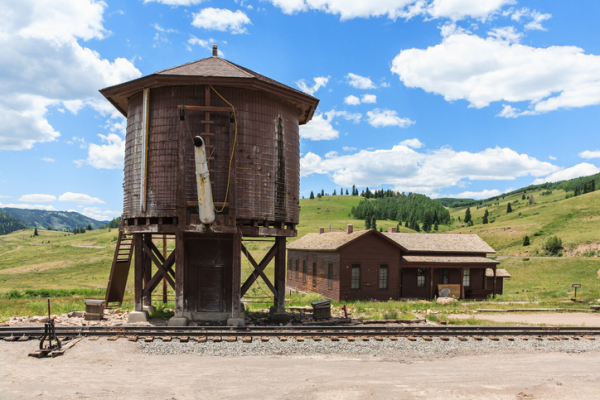
Image - Text version
Shown is a colour photograph of an octagonal wooden tower on short legs, next to railway tracks.
The tower is built from faded brown wood. The tank is wide and octagonal, with a pointed octagonal roof. It sits on short wooden legs with a wooden ladder reaching the ground. On the front, a large white plank is attached to a black stem in the middle of the wall, like the hand of a clock.
There is a single set of railway tracks in front of the tower, and a wide, low brown building behind. There are rolling green hills in the background and bright blue sky with white clouds above.
- Students could research how kinetic energy is transformed to potential energy and back again in a water tower.
- Have students research other instances of elevated water sources, such as in water coolers or steam train refilling towers.
- The water towers could be placed on slippery material and given a “shake test” to replicate an earthquake, or exposed to wind from a fan.
Grade 8 Extensions
- Students could create a hydraulic system to get water into and out of the water bottle.
- Students could add values to control the water coming out of the water bottle to make it act like a water cooler.
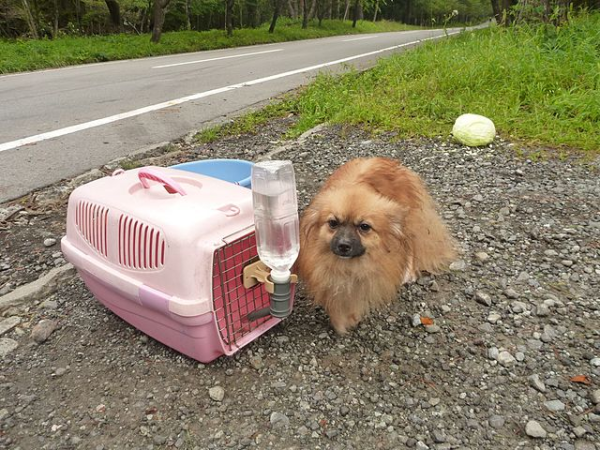
Image - Text version
Shown is a colour photograph of a dog next to a pet carrier with a water bottle attached to the door.
The bottle is clear plastic and mounted upside-down on a beige bracket. The cap on the bottom is long and grey with a spout that reaches between the wire bars of the door, into the carrier.
The carrier is pink, plastic and empty. A small, fluffy, light brown dog stands next to it, looking toward the camera.
- Students could complete a Pros and Cons Organizer comparing the structure and function of a water tower and a water reservoir.
- Students could measure the pressure of water coming out of a tube connected to the water bottle.
Literacy
- Students could apply literacy skills by submitting an information request to the local water authority that uses a water tower.
Mathematical Thinking
- Students could apply concepts of scaling by taking their model and scaling it up to life size. They may need to do research to find out the size of typical water towers.
- Students could calculate the weight (or downward force due to gravity) of the water bottle (Weight (F) = mass x g).
- If a water tower had a cylindrical tank that was 10 metres tall and had a radius of 5 metres, how many cubic metres of water could it hold? (Answer: 785.3 m3).
- The art of problem-solving website has a math problem involving the volume of a sphere used in a water tower.
Visual Arts
- Water towers often are decorated with a town’s name and imagery that represents the area. After testing is done, students could do this with their water towers.
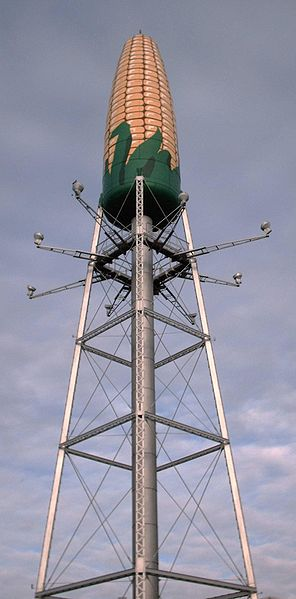
Image - Text version
Shown is a colour photograph of a water tower with a tall, narrow tank, painted with yellow kernels and green leaves.
The camera is looking up at the tank. It is round, narrow, and tapers toward the top. The base of the tank is painted with curving green leaves, and the rest with shiny yellow, oval corn kernels.
The tank is supported by a thick central stem and four metal legs connected by cross braces and wires. Eight lights fan out on arms below the tank, like petals of a flower.
Career Education
- Students could explore careers in engineering, such as by participating in the Exploring Engineering Careers lesson.
Extensions
Science
- Have students describe how their design would have to change if it had to accommodate a second 500 mL bottle or even a 2L bottle.
- Have students suggest practical applications of water containers similar to water towers in everyday life (plant watering system, water bottle for small animal cages, etc.).

Image - Text version
Shown is a colour photograph of an octagonal wooden tower on short legs, next to railway tracks.
The tower is built from faded brown wood. The tank is wide and octagonal, with a pointed octagonal roof. It sits on short wooden legs with a wooden ladder reaching the ground. On the front, a large white plank is attached to a black stem in the middle of the wall, like the hand of a clock.
There is a single set of railway tracks in front of the tower, and a wide, low brown building behind. There are rolling green hills in the background and bright blue sky with white clouds above.
- Students could research how kinetic energy is transformed to potential energy and back again in a water tower.
- Have students research other instances of elevated water sources, such as in water coolers or steam train refilling towers.
- The water towers could be placed on slippery material and given a “shake test” to replicate an earthquake, or exposed to wind from a fan.
Grade 8 Extensions
- Students could create a hydraulic system to get water into and out of the water bottle.
- Students could add values to control the water coming out of the water bottle to make it act like a water cooler.

Image - Text version
Shown is a colour photograph of a dog next to a pet carrier with a water bottle attached to the door.
The bottle is clear plastic and mounted upside-down on a beige bracket. The cap on the bottom is long and grey with a spout that reaches between the wire bars of the door, into the carrier.
The carrier is pink, plastic and empty. A small, fluffy, light brown dog stands next to it, looking toward the camera.
- Students could complete a Pros and Cons Organizer comparing the structure and function of a water tower and a water reservoir.
- Students could measure the pressure of water coming out of a tube connected to the water bottle.
Literacy
- Students could apply literacy skills by submitting an information request to the local water authority that uses a water tower.
Mathematical Thinking
- Students could apply concepts of scaling by taking their model and scaling it up to life size. They may need to do research to find out the size of typical water towers.
- Students could calculate the weight (or downward force due to gravity) of the water bottle (Weight (F) = mass x g).
- If a water tower had a cylindrical tank that was 10 metres tall and had a radius of 5 metres, how many cubic metres of water could it hold? (Answer: 785.3 m3).
- The art of problem-solving website has a math problem involving the volume of a sphere used in a water tower.
Visual Arts
- Water towers often are decorated with a town’s name and imagery that represents the area. After testing is done, students could do this with their water towers.

Image - Text version
Shown is a colour photograph of a water tower with a tall, narrow tank, painted with yellow kernels and green leaves.
The camera is looking up at the tank. It is round, narrow, and tapers toward the top. The base of the tank is painted with curving green leaves, and the rest with shiny yellow, oval corn kernels.
The tank is supported by a thick central stem and four metal legs connected by cross braces and wires. Eight lights fan out on arms below the tank, like petals of a flower.
Career Education
- Students could explore careers in engineering, such as by participating in the Exploring Engineering Careers lesson.
It's All in the Shape
Students look for shapes in structures and then build and test different frame structures for strength and stability.
How Water Towers Work
This page from How Stuff Works has more information about water towers.
Time Lapse Video of Water Tank Construction (2014)
In this video (4 min.), watch a water tower being built and hear from the people who built it.
Learn More
It's All in the Shape
Students look for shapes in structures and then build and test different frame structures for strength and stability.
How Water Towers Work
This page from How Stuff Works has more information about water towers.
Time Lapse Video of Water Tank Construction (2014)
In this video (4 min.), watch a water tower being built and hear from the people who built it.
Brain, M (May 5, 2021). How Water Towers Work. How Stuff Works.
References
Brain, M (May 5, 2021). How Water Towers Work. How Stuff Works.
Reproducibles
- Water Tower Criteria Checklist reproducible [Google doc] [Word doc] [PDF]
- Water Tower Design Journal reproducible [Google doc] [Word doc] [PDF]
- Water Tower Single-Point Rubric reproducible [Google doc] [Word doc] [PDF]
- Materials Price List and Budget [Google doc] [Word doc] [PDF]
- Water Tower 3-2-1 Exit Slip reproducible [Google doc] [Word doc] [PDF]
Videos
- How Do Water Towers Work? (2018, 4:30 min.).
- How Water Towers Work (2019, 10:59 min.) (good for Grade 8)
Reproducibles and Media
Reproducibles
- Water Tower Criteria Checklist reproducible [Google doc] [Word doc] [PDF]
- Water Tower Design Journal reproducible [Google doc] [Word doc] [PDF]
- Water Tower Single-Point Rubric reproducible [Google doc] [Word doc] [PDF]
- Materials Price List and Budget [Google doc] [Word doc] [PDF]
- Water Tower 3-2-1 Exit Slip reproducible [Google doc] [Word doc] [PDF]
Videos
- How Do Water Towers Work? (2018, 4:30 min.).
- How Water Towers Work (2019, 10:59 min.) (good for Grade 8)
Science
- Have students describe how their design would have to change if it had to accommodate a second 500 mL bottle or even a 2L bottle.
- Have students suggest practical applications of water containers similar to water towers in everyday life (plant watering system, water bottle for small animal cages, etc.).

Image - Text version
Shown is a colour photograph of an octagonal wooden tower on short legs, next to railway tracks.
The tower is built from faded brown wood. The tank is wide and octagonal, with a pointed octagonal roof. It sits on short wooden legs with a wooden ladder reaching the ground. On the front, a large white plank is attached to a black stem in the middle of the wall, like the hand of a clock.
There is a single set of railway tracks in front of the tower, and a wide, low brown building behind. There are rolling green hills in the background and bright blue sky with white clouds above.
- Students could research how kinetic energy is transformed to potential energy and back again in a water tower.
- Have students research other instances of elevated water sources, such as in water coolers or steam train refilling towers.
- The water towers could be placed on slippery material and given a “shake test” to replicate an earthquake, or exposed to wind from a fan.
Grade 8 Extensions
- Students could create a hydraulic system to get water into and out of the water bottle.
- Students could add values to control the water coming out of the water bottle to make it act like a water cooler.

Image - Text version
Shown is a colour photograph of a dog next to a pet carrier with a water bottle attached to the door.
The bottle is clear plastic and mounted upside-down on a beige bracket. The cap on the bottom is long and grey with a spout that reaches between the wire bars of the door, into the carrier.
The carrier is pink, plastic and empty. A small, fluffy, light brown dog stands next to it, looking toward the camera.
- Students could complete a Pros and Cons Organizer comparing the structure and function of a water tower and a water reservoir.
- Students could measure the pressure of water coming out of a tube connected to the water bottle.
Literacy
- Students could apply literacy skills by submitting an information request to the local water authority that uses a water tower.
Mathematical Thinking
- Students could apply concepts of scaling by taking their model and scaling it up to life size. They may need to do research to find out the size of typical water towers.
- Students could calculate the weight (or downward force due to gravity) of the water bottle (Weight (F) = mass x g).
- If a water tower had a cylindrical tank that was 10 metres tall and had a radius of 5 metres, how many cubic metres of water could it hold? (Answer: 785.3 m3).
- The art of problem-solving website has a math problem involving the volume of a sphere used in a water tower.
Visual Arts
- Water towers often are decorated with a town’s name and imagery that represents the area. After testing is done, students could do this with their water towers.

Image - Text version
Shown is a colour photograph of a water tower with a tall, narrow tank, painted with yellow kernels and green leaves.
The camera is looking up at the tank. It is round, narrow, and tapers toward the top. The base of the tank is painted with curving green leaves, and the rest with shiny yellow, oval corn kernels.
The tank is supported by a thick central stem and four metal legs connected by cross braces and wires. Eight lights fan out on arms below the tank, like petals of a flower.
Career Education
- Students could explore careers in engineering, such as by participating in the Exploring Engineering Careers lesson.
Extensions
Science
- Have students describe how their design would have to change if it had to accommodate a second 500 mL bottle or even a 2L bottle.
- Have students suggest practical applications of water containers similar to water towers in everyday life (plant watering system, water bottle for small animal cages, etc.).

Image - Text version
Shown is a colour photograph of an octagonal wooden tower on short legs, next to railway tracks.
The tower is built from faded brown wood. The tank is wide and octagonal, with a pointed octagonal roof. It sits on short wooden legs with a wooden ladder reaching the ground. On the front, a large white plank is attached to a black stem in the middle of the wall, like the hand of a clock.
There is a single set of railway tracks in front of the tower, and a wide, low brown building behind. There are rolling green hills in the background and bright blue sky with white clouds above.
- Students could research how kinetic energy is transformed to potential energy and back again in a water tower.
- Have students research other instances of elevated water sources, such as in water coolers or steam train refilling towers.
- The water towers could be placed on slippery material and given a “shake test” to replicate an earthquake, or exposed to wind from a fan.
Grade 8 Extensions
- Students could create a hydraulic system to get water into and out of the water bottle.
- Students could add values to control the water coming out of the water bottle to make it act like a water cooler.

Image - Text version
Shown is a colour photograph of a dog next to a pet carrier with a water bottle attached to the door.
The bottle is clear plastic and mounted upside-down on a beige bracket. The cap on the bottom is long and grey with a spout that reaches between the wire bars of the door, into the carrier.
The carrier is pink, plastic and empty. A small, fluffy, light brown dog stands next to it, looking toward the camera.
- Students could complete a Pros and Cons Organizer comparing the structure and function of a water tower and a water reservoir.
- Students could measure the pressure of water coming out of a tube connected to the water bottle.
Literacy
- Students could apply literacy skills by submitting an information request to the local water authority that uses a water tower.
Mathematical Thinking
- Students could apply concepts of scaling by taking their model and scaling it up to life size. They may need to do research to find out the size of typical water towers.
- Students could calculate the weight (or downward force due to gravity) of the water bottle (Weight (F) = mass x g).
- If a water tower had a cylindrical tank that was 10 metres tall and had a radius of 5 metres, how many cubic metres of water could it hold? (Answer: 785.3 m3).
- The art of problem-solving website has a math problem involving the volume of a sphere used in a water tower.
Visual Arts
- Water towers often are decorated with a town’s name and imagery that represents the area. After testing is done, students could do this with their water towers.

Image - Text version
Shown is a colour photograph of a water tower with a tall, narrow tank, painted with yellow kernels and green leaves.
The camera is looking up at the tank. It is round, narrow, and tapers toward the top. The base of the tank is painted with curving green leaves, and the rest with shiny yellow, oval corn kernels.
The tank is supported by a thick central stem and four metal legs connected by cross braces and wires. Eight lights fan out on arms below the tank, like petals of a flower.
Career Education
- Students could explore careers in engineering, such as by participating in the Exploring Engineering Careers lesson.
It's All in the Shape
Students look for shapes in structures and then build and test different frame structures for strength and stability.
How Water Towers Work
This page from How Stuff Works has more information about water towers.
Time Lapse Video of Water Tank Construction (2014)
In this video (4 min.), watch a water tower being built and hear from the people who built it.
Learn More
It's All in the Shape
Students look for shapes in structures and then build and test different frame structures for strength and stability.
How Water Towers Work
This page from How Stuff Works has more information about water towers.
Time Lapse Video of Water Tank Construction (2014)
In this video (4 min.), watch a water tower being built and hear from the people who built it.
Brain, M (May 5, 2021). How Water Towers Work. How Stuff Works.
References
Brain, M (May 5, 2021). How Water Towers Work. How Stuff Works.